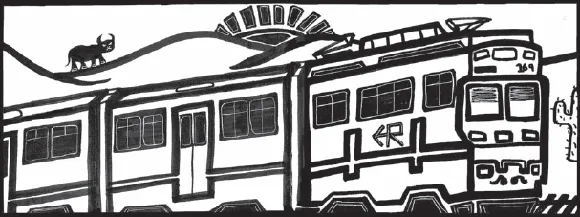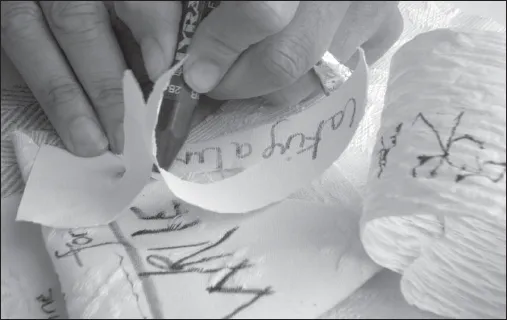![]()
1
PRINCIPLES
Fig. 5: Beginning the journey.
Introduction
This section is about the principles behind this book, and explanations of the writing approach that I take, as my work involves one-to-one tutorials with students as well as running workshops for large groups.
So, firstly, there is a section of pieces under the heading of Methods. This details the background to the workshops where writing skills are developed, and the forms and formats of work, such as journals, which are mentioned throughout the book.
Secondly, there is a short section on Reading, and how this relates to writing.
The third section is about Practice and Process, which underlines the constant theme that practice in one area will help work in another area.
Finally there is a section entitled The Writer: Self and Others, with ideas about becoming aware of the process of being a writer, and finding your writing voice.
Methods
Workshops
This is just a broad outline to give the flavour of the workshops. These are referred to in many of the Practicals so I need to give the context.
I give writing workshops for Further and Higher Education students and also for tutors in subject areas such as fashion, design, jewellery, model making, illustration, graphics, photography and fine art.
Sometimes I only work with a group once. However, more often there might be a sequence of workshops – perhaps four or five spread over a period of time and paralleling particular activities: preparation for essays and dissertations; starting journals; writing summaries; statements for application to other courses, work experience or employment; and producing creative text for a personal project.
The point of the workshop is to generate ideas, give tips, or develop particular themes – so I try to make them fun. Many participants have a block about writing so I aim to present material in a non-threatening way.
One of the first things I say at the start of a workshop, and have repeated in this book, is that I present a range of materials and it is important for the participant, as with the reader, to ‘do a pick and mix’: select some activities, discard others, adapt some, develop some, and think about others. I encourage participants to keep an open mind and make connections, so that something which feels really simple has the potential to be complex in its development.
I usually start with quick warm-up activities: setting the mood, relaxing the brain, opening up ideas. Usually there is a lot of laughter here, and noise.
Then the specific activities are geared to what the students/tutors are doing at that time, or need to do.
A lot of material is prepared in advance, as is shown with some of the exercises in this book. Often a pack is given out, consisting of handouts and samples of papers and materials to write on or about. The workshop is planned carefully so that it runs smoothly and the atmosphere that has been created is not broken, with long gaps while things are handed out. Inevitably there is some of this, but it can be turned into a bit of a rest.
Some ideas might work instantly, or an hour later; that evening, next day, week, month; or it might be several years later when the light bulb comes on. Openness to those moments is all that can be asked.
I try to allow time during the workshop, and have encouraged it throughout this book, for reflection: the pause, the thought, the making of links, forming questions, the dwelling on, the sparking off, the going off at a tangent.
The vital key is to take what is offered and then make it your own.
Reflection and Reflective Writing
Donald Schon (1991) writes of reflection in action and reflection on action, and these threads are woven through the approach to reflective journals taken in this book.
Jennifer Moon has contributed a wide range of writings about journals and reflection, and although these were never originally focused on the arts subjects, much of her work does relate quite closely. Many writers and practitioners have used her work as a starting point, and this book is no exception. She created a diagram to visualize the stages of development in reflection (Moon 1999: 35), and later (2004) developed a series of pieces of writing to show stages in reflective writing. This is a very useful principle and can be adapted to the arts. These are particularly useful for tutors new to teaching reflective practice as they show the stages clearly, and this underpins a key principle of this book: that reflective writing is not instant and has to be given time to mature. It does not spring fully formed from the page.
Reflection while doing, and on how and what you are working on, helps the journey progress and encourages exploration of alternative routes that may be tried.
Reflection after action, explaining (to self and others) through writing, writing in different voices, and considering a range of perspectives and viewpoints are the key constituents of secondary reflection. This enables us to learn from the past and to develop skills and techniques that we call on in the future.
Writing as a way of crystallizing thoughts is the attempt to make physical the random flitting thoughts in our head. Practise in trying to capture these flutters is what helps us grow as people and practitioners.
However, reflective writing doesn’t happen instantly.
For some people to whom writing comes relatively easily, exploration of thoughts will come naturally, although even some of these may need help with going deeper. But for most – it has to be developed slowly and incrementally.
Many of the exercises in this book help the early stages: moving from the initial:
‘I like …’ ‘I love …’, ‘first thought is …’
to
‘maybe …’, ‘what is it about this?…’
to
‘what if?…’, ‘could it?…’, ‘can I?…’, ‘will I?…’
and towards
‘I will …’
and
‘if I do … what happens?…’
Writing Stages Schema
The reflective process detailed previously suggests the development of a possible basic schema for writing that can be split into three stages and summarized in key words:
first stage: | explore, experiment, evaluate |
second stage: | define, develop, detail |
third stage: | personalize, professionalize, polish |
This is not meant to be an exclusive or inflexible scheme – there is much more movement backwards and forwards. But perhaps this relates to the sorts of practical exercises suggested in this book, and which can be tried at particular points in a curriculum.
It must be emphasized that in addition to movement there are other constant strands:
Reinforce reflective )
) throughout all stages
Reinforce creative )
Another feature is that all the words used in the stages are used as verbs, thus they are active.
Writing must be active and live.
Fig. 6: Actively exploring the writing line.
The Reflective Journal
The reflective journal underpins most of the practical ideas offered in this book. It is an infinitely variable tool to help all writers. It is personal, even though some parts might be offered, at times, for public perusal.
Titles for journals change from one institution to another, but the following text will describe and evaluate the key characteristics and potentialities. As Moon (1999) revealed, journals have been a significant part of practice in subjects from social work and health, and science to education, but they have been less well documented and evaluated in arts subjects. This is changing, and this book also seeks to offer ideas for these developments.
The Rationale
The aim of the Reflective Learning Journal, as its name implies, is to aid students in their own learning development, and it can be geared towards their individual professional practice.
The purpose of the journal is that, from the early stages of the course, students are logging their thought processes, developing skills of analysis of these processes, and linking these to the range of influences and subjects to which they are introduced, and from this, developing the skills of contextualization. The journal encourages the practice of articulation through writing, starting from their feelings about the material they are researching, by exploring primary and secondary resources, and by responding to advice from tutors and peers.
There is no set pattern or model for the journal; however, it is primari...


